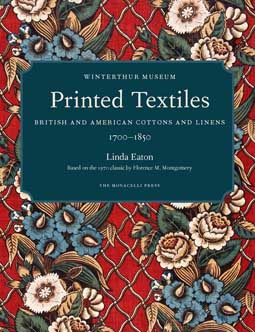 After more than four decades as the gold standard on the history of furnishing fabrics, Printed Textiles: British and American Cottons and Linens 1700-1850
After more than four decades as the gold standard on the history of furnishing fabrics, Printed Textiles: British and American Cottons and Linens 1700-1850, has been comprehensively updated by Winterthur’s Linda Eaton, the John L. & Marjorie P. McGraw Director of Collections and Senior Curator of Textiles, reflecting a universe of new information since the book’s original publication in 1970.
Available beginning September 23, 2014, Printed Textiles: British and American Cottons and Linens 1700-1850 published by the Winterthur Museum is already being hailed by critics as a rich visual sourcebook for designers and decorators even before it reaches store shelves.
“Take the ‘bones ‘of a classic volume, rewrite with updated and newly researched material, add 600 glorious color images, and you have the makings of a new standard in the field,” said Thomas Savage, Director of Museum Affairs at Winterthur.
The author, Linda Eaton, has produced a worthy sequel to Florence Montgomery’s 1970 publication, Printed Textiles, offering a fresh and thoroughly documented look at not only fabrics and techniques but also the broader worlds of commerce and material culture.
The book is based on the collection of historic furnishing textiles in Winterthur Museum, collected for more than 25 years by Winterthur founder Henry Francis du Pont and added to since his death, through purchases and the generosity of many donors.
Taking the form of quilts, curtain, slipcovers, or design repeats, the Winterthur Museum collection includes some of the finest cotton and linen textiles made or used in America and Britain between 1700 and 1850.
One of the fastest growing and potentially lucrative trades in the eighteenth and early nineteenth centuries, on the forefront of developments in science and engineering, chemistry and technology, the textile industry is a fascinating lens into international trade relations and cultural exchange over two centuries. With hundreds of beautifully photographed samples, this significant addition to textile scholarship allows for a full appreciation of these fascinating fabrics.
“People have been asking me for years when Winterthur might update PRINTED TEXTILES, and it has been tremendously exciting to build upon the seminal work of its first author, Florence Montgomery,” said Eaton.
“People relate to fabrics on a personal level, it’s something everyone can understand and feel, whether they’re wearing fabric, sitting on it, hanging it from curtain rods, admiring it on a sofa, or dressing a child. It’s ubiquitous in our lives and inherently personal.”
As Mary Schoeser, Independent Scholar, Honorary President of The Textile Society UK said, “As a model in object-based study, it was seminal in the development of the discipline now known as material culture—an achievement appropriate to Montgomery’s association with Winterthur, where the first such master’s program had been established in 1952, soon after she joined the museum.There is no doubt that this new publication, based on Montgomery’s book, will be just as influential.”
The new book is complemented by 600 glorious color images and unique new findings and insights, this updated volume richly enhances a classic reference.


